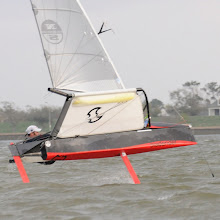

Overlay of the V6, V8 & V10 mainsail designs, note similar mold shape
In the latest Mothcast Bruce McLeod and Luka Damic raised the point that the new North Sails V-Series of models is a bit confusing (Thanks for pointing this out!). Obviously our intention was not to confuse the market, so I have tried to clarify things for potential customers. (By the way, if anyone ever has questions, please feel free to send me an email: chris at design dot northsails dot com.)
Concept- As stated before our concept and North Sail's philosophy is always to offer only the highest quality and fastest sails possible. After months of research and testing, we concluded that due to the range in rig stiffness and sailor sizes that a single sail design will never be able to compete against sails which are more optimized for a specific mast. Furthermore we we did not want to force our clients to buy a mast to match our sail design (Similar to what is done with windsurf sails).
Therefore we identified a range of luff curves for the various moth masts and then modified the sail designs to suite these masts. The V6 design therefore has 10mm more luff curve than the V8 and the V8 has 10mm more luff curve than the V10 design.By tailoring a design to a specific range of mast stiffness we can then adjust the head width and sail shape. For example, a stiffer mast can support more girth in the top easier- which is easy to accomplish with the area saved by taking out a little luff curve.
See the image below to understand the effect of luff curve on the head width:

Similarly a sail design optimized for a softer mast needs to be slightly finer in the molded shape in the front to prevent the sail from being too draft forward in lighter conditions. This effect can be seen in the image below:

Further optimization- In a perfect world our lighter clients will sail with slightly softer masts than our heavier clients. Therefore lighter sailors would end up using the V6 design and heavier sailors using the V10 design. However, as one can see in the images, the sails are not radically different from each other. A rider who wants to have a more customized quiver of designs may end up with a V10 design for lighter conditions and a V8 sail or stronger winds. This would allow the V10 sail to setup with less downhaul in light winds for a given sail depth. We will continue testing these concepts as time goes by and can help our clients decide what is the best designs for their needs.
Over the next couple weeks we will be testing different mast/sail combos and we will give our suggested setup once we have more data.
Over the next couple weeks we will be testing different mast/sail combos and we will give our suggested setup once we have more data.


No comments:
Post a Comment